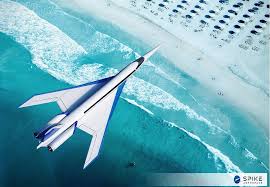Supersonic Jet Progress: A Leap Towards Faster Travel
A significant breakthrough in supersonic aviation is on the horizon, bringing the dream of transatlantic flights from New York to Paris in under four hours closer to reality. An aerospace manufacturing firm has unveiled its flagship project, the Spike S-512 Diplomat, designed to provide whisper-quiet travel over both land and sea while maintaining fuel efficiency and safety.
The ambitious goal is to trim the travel duration between these two major cities to less than four hours. Current non-stop flights with conventional planes often extend beyond seven hours. What sets this new supersonic jet apart is the promise of a quieter flight experience—one that evades the disruptive sonic boom that has historically plagued supersonic travel, including during the Concorde era. The S-512 Diplomat aims to redefine air travel by offering speed, comfort, and privacy tailored for both business leaders and discerning travelers.
The Spike S-512 Diplomat: Specifications and Innovations
The Spike S-512 is designed to accommodate \[18 passengers within its sleek 122-foot fuselage and spans 58 feet across its wings. It boasts a maximum speed of Mach 1.8 (1,189 mph) and a cruising speed of Mach 1.6 (1,056 mph), a remarkable rate that surpasses any existing civilian aircraft by approximately 500 mph. With a range of \[6,200 nautical miles (over 7,100 miles) and a service ceiling of \[50,000 feet], the aircraft promises unprecedented travel flexibility and reduced journey times.
Currently, the design phase is undergoing further enhancement to optimize its aerodynamics, cabin layout, and low-boom performance. This rigorous study aims to ensure compliance with strict noise regulations governing overland supersonic flights, which would open up new route possibilities globally.
Finding an Experienced Team to Propel Innovation
In preparation for advancing the S-512 Diplomat project, Spike Aerospace has teamed up with industry veterans from top aerospace companies, partnering also with leading academic institutions. This collaboration is critical as it accelerates not only the design and certification processes but also positions the company to enter a market eagerly awaiting the return of supersonic air travel.
Context and Historical Significance of Supersonic Travel
Historically, supersonic air travel made its debut with the Concorde, which began operations in 1976. This legendary aircraft captured public attention with its ability to fly between New York and London in just over three hours, cruising at an impressive Mach 2.04 (1,354 mph). However, safety concerns and environmental issues led to its retirement in 2003, causing many to dismiss the supersonic travel concept as relic of a bygone era.
Despite these challenges, the demand for faster international travel has remained strong. A resurgence of interest in supersonic jets is evident, with several companies now competing to reestablish commercial supersonic flights. For instance, the Colorado-based Boom Supersonic is developing the Overture jet, while Fly Concorde Ltd seeks to revive the iconic aircraft experience.
Anticipating the Future of Travel
The reemergence of supersonic travel could significantly impact international tourism, as faster travel times may enhance connectivity between major cities and spark new tourism opportunities. The ability to traverse vast distances in a fraction of the time opens up avenues for business and leisure travel alike, potentially influencing the preferences of travelers opt for quicker trips to distant destinations. Air travel, after all, remains a major facilitator in tourism dynamics across the globe.
Challenges of Returning to Supersonic Flight
Despite the excitement surrounding new technologies, challenges such as environmental concerns and regulatory hurdles continue to pose questions about the feasibility of widespread supersonic operations. Some of the obstacles include the noise pollution associated with sonic booms, which prompted prohibitions on supersonic travel over land in many regions.
Furthermore, passenger confidence was shaken post-2000, following the tragic crash of Air France Flight 4590, which halted public support for the Concorde despite its previously impeccable safety record.
Conclusion: The Promise of the Future
The ongoing developments in supersonic aviation, particularly highlighted by the progress of the Spike S-512 Diplomat, indicate a bright future ahead—one in which transatlantic flights could be accomplished with unmatched speed and quietness. This evolution in air travel will not only redefine the experience for corporate travelers but could also reshape the landscape of international tourism.
As the industry looks toward the skies with excitement, for those passionate about water adventures and the remarkable experiences they provide, remember that GetBoat.com is your go-to platform for boat rentals, ensuring your sailing escapades are just as vibrant as any flight across the oceans. Whether seeking charter yachts or boating activities, the realm of marine exploration awaits you.

 Advancements in Supersonic Travel: A Look at the Spike S-512 Diplomat">
Advancements in Supersonic Travel: A Look at the Spike S-512 Diplomat">
